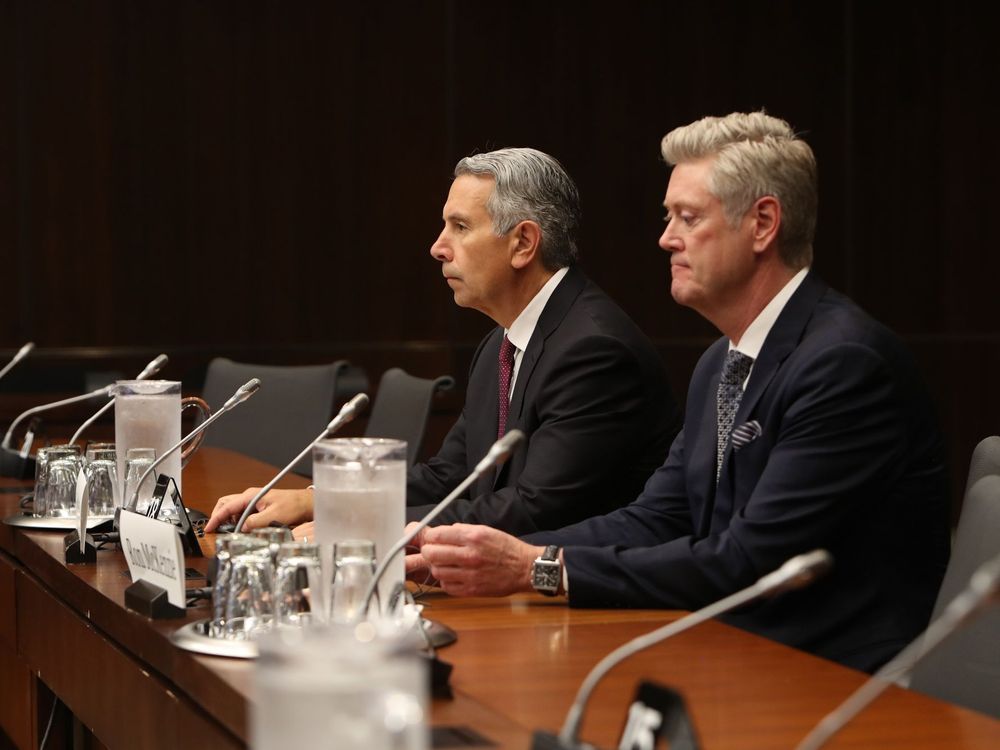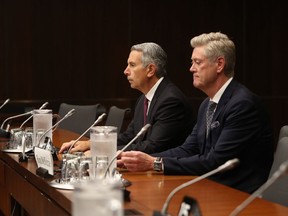‘I’m accountable for the outage’: Rogers CEO vows to make ‘urgent fixes’ during grilling before MPs

July 8 network collapse shut down wireless and internet services for 12 million people

Article content
Rogers Communications Inc. chief executive Tony Staffieri faced an hour of grilling by members of a parliamentary committee on Monday during a hearing in which he took responsibility for a massive July 8 network outage and acknowledged failing the 911, emergency alert and Interac payment systems.
“As Rogers CEO, I’m accountable for the outage,” Staffieri said in opening remarks, adding later that “there is nothing more important than the completion of 911 calls.”
Staffieri, who was named CEO in January following a power struggle between members of the Rogers family, said the company would spend $250 million to make “urgent fixes” to add redundancies and resiliency to its networks, including accelerating the split of its wireless and wireline divisions.
Advertisement 2
Story continues below
Article content
But those promises weren’t enough to placate members of the committee who questioned the telecom giant’s risk management practices and whether there should be more stringent rules and penalties to ensure essential services are protected.
MPs peppered Staffieri with questions about whether Rogers should be treated as a public utility, whether he had the confidence of his board of directors or should lose his job and whether the outage should spell the end of Rogers’ planned $26-billion acquisition of rival Shaw Communications Inc.
Staffieri gave measured responses, focusing primarily on the billions of dollars Rogers would be spending on networks over the next several years. Regarding the merger with Shaw, he said that would allow for massive investments which neither company could make on their own, and shorten the time it will take to allow Rogers to separate its wireless and wireline operations — a key decision in the aftermath of the network outage.
Advertisement 3
Story continues below
Article content
By using the existing Shaw wireline network post-merger, “this can be done in half the time,” he told the MPs.
Staffieri did the bulk of the speaking for Rogers during the session. But Ron McKenzie, who was installed as Rogers’ new chief technology officer last week, said the “unprecedented” outage — which the company says was caused by a coding error during an early-morning upgrade — should serve as a warning to other telecoms in Canada and around the world who operate as Rogers does with a common IP core.
McKenzie said the common core — which he described as the brain of the system — reacted to the upgrade and coding error “in a way that was not known.”
In a letter of explanation demanded by the Canadian Radio-television and Telecommunications Commission, Rogers said that the coding error caused a routing filter to be deleted, which resulted in “abnormally” high volumes that exceeded capacity levels and ultimately caused the common core network to stop processing traffic.
Advertisement 4
Story continues below
Article content
McKenzie said simulations are run on most network upgrades, but that such a step is not feasible when the entire core network is involved.
-

Rogers shares explanation after ‘unprecedented’ outage
-

Rogers replaces technology chief after massive outage draws fire
-
![TORONTO ONTARIO: JULY 11, 2022—COMMUNICATIONS—Customers continue to question recent day long blackout of Rogers internet, cell phone and cable services , Monday July 11, 2022. [Photo Peter J. Thompson/National Post] [National Post/TBA for National Post]](https://smartcdn.gprod.postmedia.digital/nationalpost/wp-content/uploads/2022/07/no0715rogers.jpg?h=96&strip=all&quality=5)
Rogers has its work cut out for it in outage aftermath as Shaw merger deadline looms
Staffieri said Rogers will partition its network going forward in order to contain a problem that occurs in one area. There will also be changes to processes and procedures, including the testing of code.
He said the failure of some 911 calls was a technical problem because calls that should have been automatically rerouted to a rival’s network instead continued to try to connect with the Rogers network even though it was down.
Advertisement 5
Story continues below
Article content
“Our planned solution as an industry failed,” Staffieri said, adding that fixing this problem will be a priority over the next 45 days as the industry works to create a memorandum of understanding to support one another in the event of a large outage.
He told the committee that Rogers invests about $3 billion a year, and a growing portion of that will be earmarked for network builds and improvements. Spending this year will be “double what it was last year,” he said.
During Monday’s committee hearing, MP Tracy Gray questioned whether Rogers is doing enough to manage risk, particularly to the public, given that it has now suffered two major network outages in the past 15 months. She also questioned Staffieri about why the telco manages risk through the office of its CFO, rather than having a senior Chief Risk Officer.
Advertisement 6
Story continues below
Article content
Staffieri was Rogers’ long-time chief financial officer before leaving the company last year amid a rift within the Rogers family that controls the telecom giant. He was re-hired and installed as interim CEO in November after Edward Rogers, the son of company founder Ted Rogers, received the B.C. Supreme Court’s blessing for a move to replace five independent directors.
Staffieri was named permanent CEO in January and the widespread outage now marks the second major challenge he has faced during his tenure in the top job. In May, the Competition Bureau moved to block the company’s merger with Shaw, citing concerns it would reduce wireless competition and result in higher prices for consumers. Rogers and Shaw are contesting the attempt to block the deal.
Advertisement 7
Story continues below
Article content
The CRTC and Shaw shareholders have approved the merger.
CRTC chair and chief executive Ian Scott, who also appeared before the standing committee on Monday, said Canada’s telecom networks have generally worked well, but he acknowledged that the Rogers outage was “a catastrophic failure” that requires a response.
“I don’t know of another situation where the core failed in its entirety, anywhere,” he said.
In response to questions from MPs, Scott, who previously worked at the Competition Bureau as well as at Telus and Call-Net Enterprises, said it was too early to consider imposing an administrative monetary penalty, which is within the regulator’s power. Noting that the CRTC is still collecting information about what happened at Rogers and why, he added that imposing financial penalties is meant to encourage compliance rather than to punish.
• Email: [email protected] | Twitter: BatPost
Advertisement
Story continues below


![TORONTO ONTARIO: JULY 11, 2022—COMMUNICATIONS—Customers continue to question recent day long blackout of Rogers internet, cell phone and cable services , Monday July 11, 2022. [Photo Peter J. Thompson/National Post] [National Post/TBA for National Post]](https://smartcdn.gprod.postmedia.digital/nationalpost/wp-content/uploads/2022/07/no0715rogers.jpg?h=96&strip=all&quality=80)





